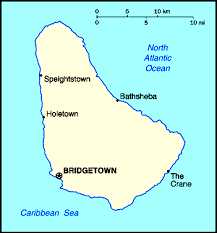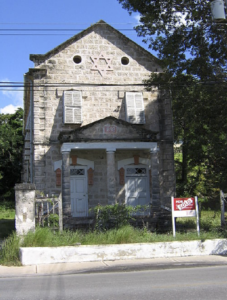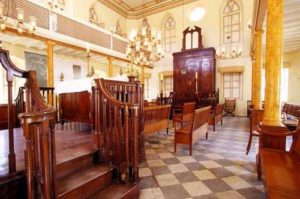The story of Jewish Barbados is one of escape, freedom, piracy, trade, secret identities, sugarcane, intermarriage, assimilation, windmills, conversion, slavery, emigration, restoration.  It is a story of mysteries and remnants. The story begins in 1627, when an English ship arrived on the newly colonized island carrying two Jews among its passengers. As Jews had been expelled from England in 1260 and would not be allowed to return until 1656, it is believed that these men were not English citizens, or at the very least hid their religious identity in order to gain passage. It is believed that there were already Jews on the island when the English ships made landfall, and that their physical appearance may have inspired the very name of the land – Los Barbudos, the bearded ones.
It is a story of mysteries and remnants. The story begins in 1627, when an English ship arrived on the newly colonized island carrying two Jews among its passengers. As Jews had been expelled from England in 1260 and would not be allowed to return until 1656, it is believed that these men were not English citizens, or at the very least hid their religious identity in order to gain passage. It is believed that there were already Jews on the island when the English ships made landfall, and that their physical appearance may have inspired the very name of the land – Los Barbudos, the bearded ones.
Jews in Barbados have existed almost continually since 1654, when Sephardic Jews arrived on the island as refugees from what was formerly Dutch Brazil after it was captured by the Inquisitorial persecuting Portuguese colonizers who were consolidating their hold over all of Brazil. The Jewish refugees brought with them expertise in the production and cultivation of sugar cane and coffee, expertise which contributed to the development of Barbados as a major producer of sugar.
 In 1654, the Jewish Nation of Barbados, successfully petitioned the Council of Barbados to establish the Sephardic Kahal Kadosh Nidhe Israel, the Sacred Congregation of the Scattered of Israel. First, they built a mikveh. Then a cemetery and the esnoga – Ladino for “synagogue,” and a community school, all on the same property.
In 1654, the Jewish Nation of Barbados, successfully petitioned the Council of Barbados to establish the Sephardic Kahal Kadosh Nidhe Israel, the Sacred Congregation of the Scattered of Israel. First, they built a mikveh. Then a cemetery and the esnoga – Ladino for “synagogue,” and a community school, all on the same property.
The synagogue was badly damaged in the Great Barbados Hurricane of 1831, rebuilt and consecrated two years later to accommodate some 300 worshippers, men on the main floor, women and children in an upstairs gallery, accessible only by an outdoor staircase behind the building.
Jews were subjected to economic restraints such as higher taxes and exemption from retail trading. All the discriminatory laws were removed by 1802, by the colonial government of Barbados and in 1820 the British Parliament also repealed the discrimination laws.
 By 1929, Edmund Baeza was the lone practicing Jew on the island. With the help of the Spanish and Portuguese Bevis Marks Synagogue in London, England, Baeza arranged for the deconsecration and sale of the synagogue building. Moshe Altman, a peddler from Lublin, Poland was on the way to Venezuela in 1931 when his ship docked in Barbados and he became enchanted with the island and decided that this is where he wanted to live. The bonus was that he would also be able to get a British passport. He recommended Barbados to people in his Shtetl and Jewish families began arriving on the island in the early seeking employment and safe haven from pogroms and the Holocaust.
By 1929, Edmund Baeza was the lone practicing Jew on the island. With the help of the Spanish and Portuguese Bevis Marks Synagogue in London, England, Baeza arranged for the deconsecration and sale of the synagogue building. Moshe Altman, a peddler from Lublin, Poland was on the way to Venezuela in 1931 when his ship docked in Barbados and he became enchanted with the island and decided that this is where he wanted to live. The bonus was that he would also be able to get a British passport. He recommended Barbados to people in his Shtetl and Jewish families began arriving on the island in the early seeking employment and safe haven from pogroms and the Holocaust.
 By 1941, 40 Jewish families from Poland had settled in Barbados. Ultimately, Moshe Altman’s call for Jews to come to Barbados led to 100-120 Jews being saved from the Holocaust and the establishment of an Ashkenazi community on the island. They purchased “True Blue,” a house, which became Shaare Tzedek, a Conservative synagogue.
By 1941, 40 Jewish families from Poland had settled in Barbados. Ultimately, Moshe Altman’s call for Jews to come to Barbados led to 100-120 Jews being saved from the Holocaust and the establishment of an Ashkenazi community on the island. They purchased “True Blue,” a house, which became Shaare Tzedek, a Conservative synagogue.
The community has never been large and today numbers between 80-100 individuals. However, the original synagogue has been restored. Errol Barrow who led Barbados to independence in 1966, and was its first Prime Minister, has Jewish ancestry. He is a descendant of the Baruch family. His great grandfather Simon Barrow changed his name from Baruch to Barrow.